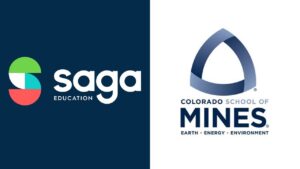At the University of Colorado Boulder and the Colorado School of Mines, two teams of college students and future engineers are developing revolutionary cutting-edge software applications that will help accelerate and expand Saga Education’s impact and reach.

Real-World Projects
Both universities run semester-long projects where senior computer science students partner with both profit and nonprofit companies to work on a real-world project. The student teams gain first-hand knowledge of what it would be like to work in that career, and companies can tap into this project’s talent pool and use it as a potential recruitment tool. In the case of Saga, it was a way to introduce students to a mission-driven organization with an award-winning engineering team.
Technology for Educators by Educators
Early in 2021, 64% of students across America were enrolled in distance learning–completely online or a hybrid model. Given the uncertainty of COVID-19, this created a strong need for high-quality online learning environments that replicate in-person classroom instructional conditions.
However, video conferencing technologies are not designed with educators in mind, and are not optimized for student learning. Saga’s world-class engineering team built its own online learning platform called Saga Connect, which has the technology to facilitate live tutor-student interactions.
Saga Connect offers educators the ability to see a student work through a problem and talk it out in real-time. This technology can replicate in-person instruction, deepen relationships and help students with confidence building. That is why Saga Connect is available to all educators throughout the country, However, it needs to overcome one significant challenge–operational cost.
Make Technology Scalable
Sean Kelly, vice president of engineering for Saga Education, developed a project definition: to find out if there was a more efficient and cost-effective way of improving the audio-visual (a/v) technology for Saga Connect. If the student groups could find a way to make the a/v technology more economical and even improve on the user experience, Saga Connect could have the potential to reach more people.
“We wanted to find a way to make Saga Connect more scalable. Currently, Saga Connect uses audio-video conferencing technology that can be cost-prohibitive for some schools and organizations. I came up with the idea to use open-source technology that has the same infrastructure at little to no cost,” said Kelly.
Mentor and Guide Students
For Kelly, this project was an opportunity to mentor and guide these students and expose them to Saga. For the students, it was an opportunity to boost their portfolios, showcase their knowledge and lead them to possible internships or even careers at Saga.
Project Management
Working directly with the students was important. “I treated them like they were an engineering team who worked for Saga,” said Kelly. This meant twice-weekly meetings, project deliverables and a group presentation at the end of the project. The result was a prototype of an a/v solution that Saga’s engineering team may use as a jumping-off point for future projects. The project was so successful that the team from the Colorado School of Mines was elected “Best Technical Presentation” by their peers.
Diverse Team for a Diverse Audience
Kelly sees the student groups as an extension of Saga’s mission. “Saga’s mission is to help kids learn. I feel like this kind of community involvement has that same ethos,” he said. “Reaching out to traditionally underrepresented groups in engineering was an important part of this project. I’m always looking for engineers with diverse backgrounds, because diversity builds better products. If we build a diverse team, then our products will appeal to a more diverse audience,” said Kelly. Plus, like any good teacher, Kelly added that “there’s “a lot of joy in helping students learn.”
